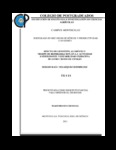| dc.contributor.author | Velázquez Rodríguez, Sergio Raúl | |
| dc.creator | VELÁZQUEZ RODRÍGUEZ, SERGIO RAÚL; 373655 | |
| dc.date.accessioned | 2013-09-11T19:42:21Z | |
| dc.date.available | 2013-09-11T19:42:21Z | |
| dc.date.issued | 2013 | |
| dc.identifier.uri | http://hdl.handle.net/10521/2040 | |
| dc.description | Tesis (Maestría en Ciencias, especialista en Ganadería).- Colegio de Postgraduados, 2013. | en_US |
| dc.description.abstract | Se evaluó la actividad antioxidante (AA) de cuatro alimentos comerciales (1, 2, 3 y 4) en la actividad antioxidante y estabilidad oxidativa (EO) de lomo crudo (Longissimus dorsi) de conejos de tres genotipos (Nueva Zelanda, NZ, California, CAL y NZ*CAL) a tres tiempos de refrigeración (0, 3, y 6 días). La AA de todos los alimentos disminuyó a los 30 días de almacenamiento; sin embargo, el alimento 1 presentó mayor cantidad de antioxidantes (p<0.05). Con todos los genotipos y alimentos, la AA del lomo crudo disminuyó al día 6 de refrigeración. El genotipo NZ*CAL presentó mayor AA con el alimento 1 (p<0.05) y menor con el alimento 3 con respecto al genotipo NZ. Todos los genotipos presentaron un incremento de la oxidación lipídica a partir del día 3 de refrigeración (p<0.05) y la EO mejoró al aumentar la cantidad de antioxidantes. La cruza NZ*CAL presentó mejor EO cuando recibió el alimento 1 y fue peor cuando recibió el alimento 3. La EO de NZ mejoró cuando recibió el alimento 3 y empeoró cuando recibió el alimento 1, con respecto a NZ*CAL. El genotipo NZ presentó mayor susceptibilidad a la oxidación con el alimento 4 durante todo el periodo de refrigeración (p<0.05). Adicionalmente, la EO del lomo crudo disminuyó al transcurrir el tiempo de refrigeración (p<0.05). Se sugiere alimentar a NZ*CAL con alimentos con más de 85 % de AA y no refrigerar más de 6 días para prevenir el aumento de la oxidación lipídica. _______________ EFFECT OF GENOTYPE, FEED AND REFRIGERATION TIME, ON THE ANTIOXIDANT ACTIVITY AND OXIDATIVE STABILITY OF RAW LOIN OF RABBIT. ABSTRACT: The antioxidant activity (AA) was evaluated of four commercial feed (1, 2, 3 and 4) on antioxidant activity and oxidative stability (EO) of raw loin (Longissimus dorsi) of rabbits of three genotypes (New Zealand, NZ, California, CAL, and NZ * CAL) to three refrigeration times (0, 3, 6 days). The AA of all feeds decreased to 30 days of storage. However, the 1 feed presented greater antioxidants amount (p < 0.05). With food and all the genotypes, the AA of the raw loin declined to day 6 of cooling. The NZ*CAL genotype presented higher AA with feed 1 (p < 0.05) and less with 3 feed with respect to genotype NZ. All genotypes had an increase in lipid oxidation from day 3 of refrigeration (p < 0.05) and the EO improved by increasing the amount of antioxidants. The NZ*CAL croos presented best EO when it received 1 feed and was worse when he received 3 feed. The EO of NZ improved when received 3 feed and worsened when he received the food 1 with respect to NZ*CAL. The NZ genotype presented higher susceptibility to oxidation with 4 feed during the entire cooling period (p < 0.05). In addition, the EO of the raw loin decreased at the time of refrigeration (p < 0.05). Suggested feeding NZ*CALwhit feeds with more than 85% of AA and not refrigerate more than 6 days to prevent the increase of lipid oxidation. | en_US |
| dc.description.sponsorship | Consejo Nacional de Ciencia y Tecnología (CONACYT). | en_US |
| dc.language.iso | spa | en_US |
| dc.rights.uri | http://creativecommons.org/licenses/by-nc-nd/4.0 | |
| dc.subject | Nutrición | en_US |
| dc.subject | Calidad de carne | en_US |
| dc.subject | Oxidación lipídica | en_US |
| dc.subject | Carne de conejo | en_US |
| dc.subject | Vida de anaquel | en_US |
| dc.subject | Nutrition | en_US |
| dc.subject | Meat quality | en_US |
| dc.subject | Lipid oxidation | en_US |
| dc.subject | Rabbit meat | en_US |
| dc.subject | Shelflife | en_US |
| dc.subject | Ganadería | en_US |
| dc.subject | Maestría | en_US |
| dc.title | Efecto de genotipo, alimento y tiempo de refrigeración, en la actividad antioxidante y estabilidad oxidativa de lomo crudo de conejo | en_US |
| dc.type | Tesis | en_US |
| Tesis.contributor.advisor | Pro Martínez, Arturo | |
| Tesis.contributor.advisor | Narciso Gaytán, Carlos | |
| Tesis.contributor.advisor | Sosa Montes, Eliseo | |
| Tesis.contributor.advisor | Suárez López, Jesús Ruvisel | |
| Tesis.date.submitted | 2013 | |
| Tesis.date.accesioned | 2013-09-02 | |
| Tesis.date.available | 2013-09-11 | |
| Tesis.format.mimetype | pdf | en_US |
| Tesis.format.extent | 2,340 KB | en_US |
| Tesis.subject.nal | Lomos (corte de carne) | en_US |
| Tesis.subject.nal | Loins (meat cut) | en_US |
| Tesis.subject.nal | Antioxidantes | en_US |
| Tesis.subject.nal | Antioxidants | en_US |
| Tesis.subject.nal | Valor nutritivo | en_US |
| Tesis.subject.nal | Nutritive value | en_US |
| Tesis.subject.nal | Refrigeración | en_US |
| Tesis.subject.nal | Refrigeration | en_US |
| Tesis.subject.nal | Montecillo, Estado de México, México | en_US |
| Tesis.rights | Acceso abierto | en_US |
| Articulos.subject.classification | Industria de la carne de conejo | en_US |
| dc.type.conacyt | masterThesis | |
| dc.identificator | 6 | |
| dc.contributor.director | PRO MARTINEZ, ARTURO; 6277 | |


